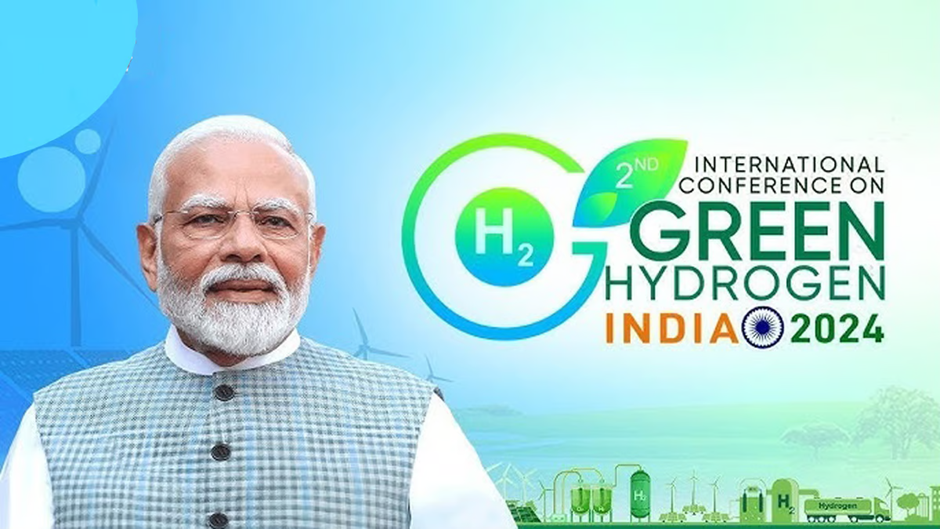- Courses
- GS Full Course 1 Year
- GS Full Course 2 Year
- GS Full Course 3 Year
- GS Full Course Till Selection
- MEP (Mains Enrichment Programme) Data, Facts
- Essay Target – 150+ Marks
- Online Program
- GS Recorded Course
- NCERT- First Ladder
- Polity
- Geography
- Economy
- Ancient, Medieval and Art & Culture AMAC
- Modern India, Post Independence & World History
- Environment
- Governance
- Science & Technology
- International Relations and Internal Security
- Disaster Management
- Ethics
- Current Affairs
- Indian Society and Social Issue
- CSAT
- 5 LAYERED ARJUNA Mentorship
- Public Administration Optional
- ABOUT US
- OUR TOPPERS
- TEST SERIES
- FREE STUDY MATERIAL
- VIDEOS
- CONTACT US
PM addresses second International Conference on Green Hydrogen
PM addresses second International Conference on Green Hydrogen
14-09-2024

Prime Minister Narendra Modi recently addressed the second International Conference on Green Hydrogen 2024 (ICGH-2024), held at Bharat Mandapam, New Delhi. He emphasized the necessity of international cooperation to enhance green hydrogen production, reduce associated costs, and advance research and development.
Key Highlights of ICGH-2024:
India's Achievements:
- Paris Commitments: India is among the first G20 nations to meet its Paris Agreement commitments on green energy, achieving its targets nine years ahead of the 2030 deadline.
- Energy Goals: India has pledged to increase its non-fossil energy capacity to 500 GW and reduce projected carbon emissions by 1 billion tonnes by 2030.
- Capacity Increase: Non-fossil fuel capacity in India has grown by nearly 300% over the past decade.
Emerging Importance of Green Hydrogen:
- Decarbonization: Green hydrogen is crucial for decarbonizing sectors that are difficult to electrify, such as refineries, fertilizers, steel production, and heavy-duty transportation.
- Energy Storage: It also acts as a storage solution for surplus renewable energy, offering a way to manage energy supply and demand.
Investment in Research:
- The conference advocated for increased investment in research and development, encouraging partnerships between industry and academia and supporting start-ups and entrepreneurs in the green hydrogen sector.
- The Prime Minister urged experts and the scientific community to lead the adoption of green hydrogen technologies.
G20 Summit Insights:
- Hydrogen Principles: The New Delhi G-20 Leaders’ declaration introduced five high-level voluntary principles on hydrogen, aiding in the creation of a unified roadmap for hydrogen development.
- Critical Questions: The PM highlighted the need to improve electrolyser efficiency, explore the use of seawater and municipal wastewater for hydrogen production, and assess green hydrogen's role in public transport and shipping.
India’s Upcoming Initiatives:
- European Hydrogen Week Partnership: India has announced a partnership with European Hydrogen Week in November 2024, focusing on aligning with the EU's green regulations.
- Hydrogen-Fueled Train Trials: Indian Railways plans to trial the first hydrogen-fueled train in January 2025, converting a 1200 KW DEMU (Diesel Electric Multiple Unit) into a hydrogen fuel cell-based DPRS (Distributed Power Rolling Stock).
Why is International Cooperation Needed?

High Production Costs:
- Cost Range: The cost of producing green hydrogen is between USD 3 to USD 8 per kilogram, significantly higher than grey hydrogen produced from fossil fuels.
Technology and Infrastructure Investment:
- Electrolyser Costs: Although the cost of alkaline electrolysers decreased by 40% between 2014 and 2019, further reductions are necessary to make green hydrogen competitive.
- Electrolysis Costs: Producing green hydrogen through electrolysis requires substantial electricity, keeping production costs high compared to conventional hydrogen.
Efficiency and Resource Challenges:
- Electrolyzer Efficiency: Current electrolyzers are not yet efficient enough for widespread adoption. Research is needed to improve efficiency and reduce costs.
- Resource Availability: The scarcity of rare materials like platinum and iridium needed for electrolyzers and fuel cells can limit scalability.
Scaling Up Production:
- Investment Needs: Achieving the scale necessary for green hydrogen production requires substantial investment, with estimates suggesting Asia needs USD 90 billion by 2030.
How International Cooperation Can Help?
Scaling Up Production:
- Joint Ventures: Cross-border collaborations can accelerate green hydrogen production by leveraging diverse technological capabilities and resources.
- Economies of Scale: Joint international initiatives can reduce costs through shared investments and bulk purchasing. For example, the “HyDeal Ambition” project aims to deliver green hydrogen across Europe at a low cost of Euro 1.5/kg.
Shared Infrastructure:
- Cost Reduction: Collaborative infrastructure projects can lower costs for production, storage, and distribution of green hydrogen. Regional networks, like those by the Asia-Pacific Hydrogen Association, showcase how shared facilities can reduce costs.
Innovation Through Partnerships:
- Global Platforms: Platforms like the Global Hydrogen Coalition bring together governments, industry leaders, and research institutions to drive innovation in hydrogen technologies.
Unified Policies and Regulations:
- Coordinated Policies: International collaboration helps in developing cohesive policies and regulations that support green hydrogen. The 2023 G20 Summit adopted principles that aid in creating a common roadmap.
Investment and Funding:
- Research Initiatives: Joint funding and investment initiatives, such as those within Horizon Europe’s Clean Hydrogen Partnership, accelerate research and deployment of green hydrogen technologies.
Conclusion:
International cooperation is pivotal for advancing green hydrogen. By sharing technology, harmonizing policies, and pooling investments, countries can overcome production and infrastructure challenges. Collaborative efforts will ensure efficient global supply chains, reduce costs, and foster public acceptance, ultimately accelerating the transition to a sustainable energy future and maximizing the potential of green hydrogen.
Must Check: Best IAS Coaching In Delhi
UPSC Prelims Result 2024 Out: Expected Cut Off & Other Details, UPSC Prelims 2024 Answer with Explanation, Daily Prelims Quiz, Daily Current Affairs, MONTHLY CURRENT AFFAIRS TOTAL (CAT) MAGAZINE, Best IAS Coaching Institute in Karol Bagh, Best IAS Coaching Institute in Delhi, Daily Mains Question Answer Practice, ENSURE IAS UPSC Toppers, UPSC Toppers Marksheet, Previous Year Interview Questions, UPSC Syllabus




